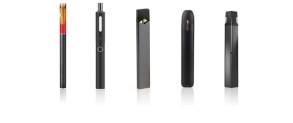FDA Warns of Youth Epidemic of E-Cigarette Use, Faces Regulatory Challenges
Background
An electronic cigarette (e-cigarette) is a battery-operated device typically containing nicotine, flavorings, and other chemicals that create inhalable vapor. According to the 2018 National Academy of Sciences (NAS) report, Public Health Consequences of E-Cigarettes, e-cigarette vapor contains fewer toxicants than combusted cigarette smoke.
In a recent announcement, Commissioner of the Food and Drug Administration (FDA) Scott Gottlieb wrote:
The FDA now believes that youth use of e-cigarettes is reaching epidemic proportions. This belief is based on not just the results of the agency's enforcement actions, but also recent sales trends, news coverage, increased concerns among kids, parents and educators, as well as preliminary data that will be finalized and released in the coming months.
In a Washington Post joint editorial, HHS Secretary Alex Azar and Commissioner Gottlieb stated that these preliminary Centers for Disease Control and Prevention (CDC) data found a 75% increase in e-cigarette use among high school students and a 50% increase among middle school students from 2017 to 2018. According to a published CDC survey fielded in 2017, an estimated 2.1 million middle and high school students used e-cigarettes in the past 30 days.
In recent months, FDA has taken enforcement actions to address the sale and marketing of e-cigarettes to minors. These actions include (1) warning letters and fines to retailers that sold e-cigarettes illegally to minors; (2) warning letters for online retailers using misleading youth-oriented labels on nicotine-containing "e-liquids"; and (3) warning letters to the top-selling (in unit sales) e-cigarette brands JUUL, Vuse, MarkTen XL, blu, and Logic. (According to FDA, these brands make up over 97% of the U.S. e-cigarette market. JUUL makes up about 70% of the e-cigarette market and was valued at $15 billion in June 2018). These actions are part of FDA's Youth Tobacco Prevention Plan to stop tobacco use among youth.
While e-cigarettes were almost unknown when FDA was first given authority to regulate tobacco products in 2009, they have become a significant issue for FDA in recent years. This is reflected, in part, by increased congressional interest in e-cigarettes, including legislation (e.g., H.R. 1136 and S. 3319) introduced during the 115th Congress aimed at regulation of e-cigarettes.
Health concerns related to e-cigarette use among youth
The 2016 report of the U.S. Surgeon General, E-Cigarette Use Among Youth and Young Adults, stated that the ability of e-cigarettes "to deliver comparable or higher amounts of nicotine compared to conventional cigarettes raises concern about e-cigarette use generating nicotine dependence among young people." Early nicotine exposure can lead to negative health effects. A literature review by CDC authors cited studies finding that nicotine exposure during adolescence and young adulthood can cause lasting cognitive and mood impairments. In addition, nicotine exposure in e-cigarettes may lead youth to use more harmful combustible products. The NAS Report stated that "for youth and young adults, there is substantial evidence that e-cigarette use increases the risk of ever using combustible tobacco cigarettes."
|
Figure 1. Examples of Different E-Cigarette Products |
 |
|
Source: The US Food and Drug Administration (FDA), https://www.fda.gov/. |
Research articles have found that flavored e-cigarettes are popular among both youth and adults, and that these flavorings could also contain respiratory toxicants.
FDA faces challenges in regulating e-cigarettes
Cigarettes, cigarette tobacco, roll-your-own tobacco, and smokeless tobacco were originally covered by FDA's tobacco product authorities in Chapter IX of the Federal Food, Drug & Cosmetics Act (21 U.S.C. §387a-387u) when the 2009 Family Smoking Prevention and Tobacco Control Act (P.L. 111-31) went into effect. In 2016, FDA promulgated regulations (e.g., 21 C.F.R. § 1100) that extend authority over all products meeting the definition of a tobacco product, including e-cigarettes. FDA continues to work on regulatory challenges, namely regulating e-cigarettes as part of a harm reduction strategy. Harm reduction refers to the replacement of a more harmful activity with a less harmful one when elimination of the activity is difficult or infeasible. In this case, are e-cigarettes a less harmful alternative than combustible tobacco, or do they make future use of combustible tobacco more likely? Or both?
FDA generally has the authority to adopt tobacco product standards if the agency determines that the standard is appropriate to protect public health (21 U.S.C. §387g). In adopting such standards, FDA must consider, among other things, scientific evidence about the risks and benefits of a product to the population as a whole. This regulatory process has proved challenging for FDA when considering premarket review of e-cigarettes. According to Commissioner Gottlieb:
E-cigarettes may present an important opportunity for adult smokers to transition off combustible tobacco products and onto nicotine delivery products that may not have the same level of risks associated with them…. We need a regulatory process that requires product applications to show that the marketing of the product is appropriate for the protection of the health of the overall population. And we need a regulatory process that keeps these same electronic cigarette products out of the hands of youth.
In 2017, FDA issued a "Guidance for Industry" document that pushed back premarket review compliance deadlines to 2022 for e-cigarettes on the market as of August 8, 2016. This administrative action is currently subject to legal challenge, but FDA has also indicated it may revisit these deadlines or take further enforcement actions (e.g., removal from the market until premarket approval is granted) if e-cigarette manufacturers do not develop plans to reduce youth e-cigarette use that address FDA's concerns. FDA is also considering regulation of flavors in e-cigarettes that strikes a balance between discouraging use among youth and encouraging adult cigarette smokers to switch to e-cigarettes.
Given the rapid expansion and size of the e-cigarette market (in dollars and users), it is unclear whether FDA has all the regulatory tools it needs to respond to a situation that was largely not anticipated a decade ago when Congress first granted FDA authority to regulate tobacco products.